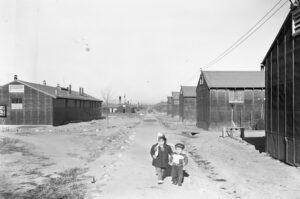Discover the History ofWWII Incarceration

120,000 Japanese Americans were unjustly incarcerated during World War II. Learn about this unprecedented denial of civil liberties and why it still matters today.
Explore Personal Stories

Learn about Japanese American history and the legacy of WWII incarceration by exploring personal stories from those who lived through it.
Promote Equity Today

History doesn’t repeat itself, but it often rhymes. Join us in putting the lessons of Japanese American WWII incarceration into action today.
Densho Catalyst: History, Essays, & Opinion
Dive into hidden histories and learn why these stories matter today with the latest essays and opinions from Densho and other community voices.

Kanon Shambora on the Making of Print Garden
Artist-in-residence Kanon Shambora used her time at Densho to explore the roots of Japanese American identity. Their culminating Print Garden pays homage to early Issei and Nisei, as well as...
Justifying the Unjustifiable: Why Japanese Americans Must Stand with Palestine
Guest opinion essay by Maggie Tokuda-Hall. Densho publishes guest opinion essays that draw meaningful connections between the incarceration story and the present, and that promote equity and justice today. Learn...
Ask a Historian: When Did America Start Building Its WWII Concentration Camps?
Densho Content Director Brian Niiya answers a question about the origin of the concentration camps where Japanese Americans were imprisoned during World War II.
Manzanar CloseUp
Welcome to Densho’s newest digital platform, Manzanar CloseUp! An evolution of Densho’s popular Sites of Shame project, Manzanar CloseUp applies similar data extraction and visualization tools to offer a close-up view of Manzanar concentration camp. Users are able to see geographical and population features of the camp with an unprecedented level of detail, including information about camp population down to the individual family and barrack level.Â

Stay Informed: Join The Mailing List


Campu: A Podcast
Campu weaves together the voices of survivors to spin narratives out of the seemingly mundane things that gave shape to the incarceration experience: rocks, fences, food, paper. Follow along as hosts Hana and Noah Maruyama move far beyond the standard Japanese American incarceration 101 and into more intimate and lesser-known corners of this history.

Encyclopedia
Thousands of articles about the history of the Japanese American WWII exclusion and incarceration experience. Here are a few to get you started:
Moab/Leupp Isolation Centers (detention facility)
In the wake of the Manzanar Riot of 1942, the WRA established a "temporary" isolation center for "troublemakers" at a recently shuttered Civilian Conservation Corps facility in southeastern Utah.
442nd Regimental Combat Team
The 442nd Regimental Combat Team comprised of Japanese American draftees from Hawai'i and became the most decorated unit in U.S. military history for its size and length of service.
Oyama v. California
The 1948 U.S Supreme Court case that struck down certain provisions of California's notorious Alien Land Act as applied against U.S. citizens of Japanese ancestry.



